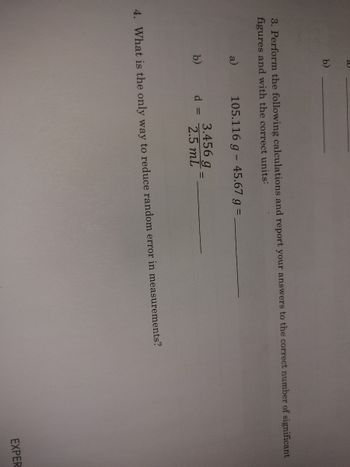
Chemistry
10th Edition
ISBN: 9781305957404
Author: Steven S. Zumdahl, Susan A. Zumdahl, Donald J. DeCoste
Publisher: Cengage Learning
expand_more
expand_more
format_list_bulleted
Concept explainers
Question
thumb_up100%
What are the answers for the following questions?

Transcribed Image Text:### Significant Figures in Scientific Calculations
**3. Perform the following calculations and report your answers to the correct number of significant figures and with the correct units:**
a) \( 105.116 \, \text{g} - 45.67 \, \text{g} = \) __________
b) \( d = \frac{3.456 \, \text{g}}{2.5 \, \text{mL}} = \) __________
---
**4. What is the only way to reduce random error in measurements?**
---
In this exercise, students are asked to perform calculations that involve significant figures and accurate reporting of measurement units. Below we detail the processes and principles needed to solve these problems:
1. **Subtraction of Masses (Part 3a)**:
- To find the difference between two masses, subtract the given values ensuring that the result is reported with the correct number of significant figures.
- Example Calculation Steps:
- Subtract \( 45.67 \, \text{g} \) from \( 105.116 \, \text{g} \).
- Determine the number of significant figures in each measurement and report your final answer accordingly.
2. **Density Calculation (Part 3b)**:
- To calculate the density (\(d\)), use the formula \( d = \frac{m}{V} \), where \( m \) is the mass and \( V \) is the volume.
- Example Calculation Steps:
- Divide \( 3.456 \, \text{g} \) by \( 2.5 \, \text{mL} \).
- Ensure the final result is reported with the correct number of significant figures based on the least precise measurement in your calculation.
**Part 4**:
- **Reducing Random Error**:
- Random errors can be reduced by taking multiple measurements and averaging them. This improves reliability and accuracy in scientific experiments. The only way to lessen random error is by increasing the sample size or the number of trials, thereby minimizing the impact of outliers or anomalies.
By understanding and applying the concept of significant figures, students will be able to report their experimental results more accurately.
Expert Solution
This question has been solved!
Explore an expertly crafted, step-by-step solution for a thorough understanding of key concepts.
This is a popular solution
Trending nowThis is a popular solution!
Step by stepSolved in 3 steps with 2 images

Knowledge Booster
Learn more about
Need a deep-dive on the concept behind this application? Look no further. Learn more about this topic, chemistry and related others by exploring similar questions and additional content below.Similar questions
- A normal fasting blood sugar level is 0.0039 – 0.0055 mol / L. For a 3.0 x 10-4 mL sample of blood, calculate the maximum mass of glucose, C6H12O6, (in grams) that corresponds to a normal result.arrow_forwardCompare the experimental and theoretical results of Benedict’s, Barfoed’s, Selliwanoff’s, Bial’s tests. Explain any discrepancies.arrow_forwardOn a soap molecule, identify which end is known as being polar and which end is known as being nonpolar. Based off of this analysis, label which end is hydrophobic and which one is hydrophilic. Define hydrophobic and hydrophilicarrow_forward
- Explain why Chiral molecules are expected to interact with plane polarized light?arrow_forwardMarks: 1 Stereochemistry is the study of: Choose one answer. a. organic chemistry b. two-dimensional chemistry c. theoretical chemistry d. three-dimensional chemistryarrow_forwardWhich of the following factors primarily dictates the distribution of terrestrial biomes on Earth? The history of human development and civilization ㅎㅎㅎ The population density of animals Climate variables like temperature and precipitation The prevalence of certain rock and soil typesarrow_forward
- Identify the hydrophobic and hydrophilic region(s) of a triglyceride.arrow_forwardGlycosaminoglycans (GAGs) are heteropolysaccharides composed of repeating disaccharide units. These units have some similar characteristics that allow them to be identified as GAGS. Which of the structures are examples of glycosaminoglycans? А. C. E. HO HO COO™ H Н ОН Н CH₂OH H H H OH OH Н CH₂OH Н OH H ОН o,so H H Н CH₂OH H H ОН H CH₂OSO H NH C=0 CH, H H Н NH c=0 CH3 H CH,OH OH Н ОН OH H B. D. Н НО H ОН H CH₂OH H ОН Н СОО ОН Н Н H H OSoz H Н OH б H CH₂OH ОН CH₂OSO H ОН H Н OSO, H Н NHSO,arrow_forwardHow does carminic acid a (organic compound) allow them to function as a pigments in 2-3 sentences.arrow_forward
- Classify the following disaccharide. a. beta 1-2 disaccharide b. alpha 1-4 disaccharide c. alpha 1-6 disaccharide d. alpha 1-2 disaccharide e. beta 1-4 disaccharide f. beta 1-6 disaccharidearrow_forwardWhich of the following is inorganic? vitamins water lipids carbohydratesarrow_forwardIs disaccharide “4” a reducing sugar?arrow_forward
arrow_back_ios
SEE MORE QUESTIONS
arrow_forward_ios
Recommended textbooks for you
 ChemistryChemistryISBN:9781305957404Author:Steven S. Zumdahl, Susan A. Zumdahl, Donald J. DeCostePublisher:Cengage Learning
ChemistryChemistryISBN:9781305957404Author:Steven S. Zumdahl, Susan A. Zumdahl, Donald J. DeCostePublisher:Cengage Learning ChemistryChemistryISBN:9781259911156Author:Raymond Chang Dr., Jason Overby ProfessorPublisher:McGraw-Hill Education
ChemistryChemistryISBN:9781259911156Author:Raymond Chang Dr., Jason Overby ProfessorPublisher:McGraw-Hill Education Principles of Instrumental AnalysisChemistryISBN:9781305577213Author:Douglas A. Skoog, F. James Holler, Stanley R. CrouchPublisher:Cengage Learning
Principles of Instrumental AnalysisChemistryISBN:9781305577213Author:Douglas A. Skoog, F. James Holler, Stanley R. CrouchPublisher:Cengage Learning Organic ChemistryChemistryISBN:9780078021558Author:Janice Gorzynski Smith Dr.Publisher:McGraw-Hill Education
Organic ChemistryChemistryISBN:9780078021558Author:Janice Gorzynski Smith Dr.Publisher:McGraw-Hill Education Chemistry: Principles and ReactionsChemistryISBN:9781305079373Author:William L. Masterton, Cecile N. HurleyPublisher:Cengage Learning
Chemistry: Principles and ReactionsChemistryISBN:9781305079373Author:William L. Masterton, Cecile N. HurleyPublisher:Cengage Learning Elementary Principles of Chemical Processes, Bind...ChemistryISBN:9781118431221Author:Richard M. Felder, Ronald W. Rousseau, Lisa G. BullardPublisher:WILEY
Elementary Principles of Chemical Processes, Bind...ChemistryISBN:9781118431221Author:Richard M. Felder, Ronald W. Rousseau, Lisa G. BullardPublisher:WILEY

Chemistry
Chemistry
ISBN:9781305957404
Author:Steven S. Zumdahl, Susan A. Zumdahl, Donald J. DeCoste
Publisher:Cengage Learning

Chemistry
Chemistry
ISBN:9781259911156
Author:Raymond Chang Dr., Jason Overby Professor
Publisher:McGraw-Hill Education

Principles of Instrumental Analysis
Chemistry
ISBN:9781305577213
Author:Douglas A. Skoog, F. James Holler, Stanley R. Crouch
Publisher:Cengage Learning

Organic Chemistry
Chemistry
ISBN:9780078021558
Author:Janice Gorzynski Smith Dr.
Publisher:McGraw-Hill Education

Chemistry: Principles and Reactions
Chemistry
ISBN:9781305079373
Author:William L. Masterton, Cecile N. Hurley
Publisher:Cengage Learning

Elementary Principles of Chemical Processes, Bind...
Chemistry
ISBN:9781118431221
Author:Richard M. Felder, Ronald W. Rousseau, Lisa G. Bullard
Publisher:WILEY